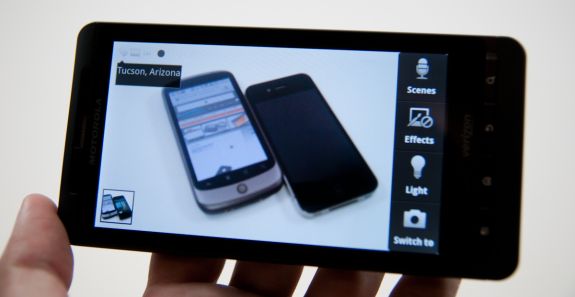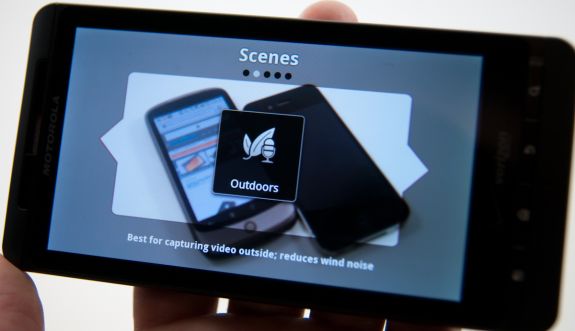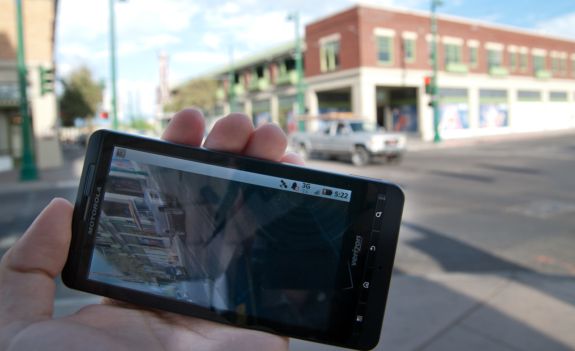Motorola Droid X: Thoroughly Reviewed
by Brian Klug on July 20, 2010 4:27 PM EST- Posted in
- Smartphones
- Motorola Droid X
- OMAP
- Mobile
Video
The X joins a number of smartphones shooting 720P video. It shoots 1280x720 video in MPEG-4 format at a full 30 FPS with AAC audio. This is up from the 24 FPS of the original Motorola Droid as mentioned earlier. Average video bitrate is nearly 1 megabyte/s. As expected, you can force the LED on and shoot video with illumination. 720P video capture is limited to 30 minutes at a time.
The layout of the video interface is virtually identical to the still interface. You can launch camcorder to get directly to shooting video, or just use camera for stills, or either one and switch between.
I found video quality to be almost as good as the iPhone 4’s, which is arguably the current leader. The EVO 4G’s video looks oversaturated and uses a noticeably worse audio codec, AMR narrowband. Though video bitrate is almost the same, I notice more blocking in the EVO 4G’s video than the X’s. I shot the X and EVO videos in the same hand at the exact same time, so feel free to do comparison on your own. Still, it’s hard to deny that the X’s video doesn’t look much more like what you’d expect, and the difference is all software and that SoC difference surprisingly.
Motorola Droid X
HTC EVO 4G
Nexus One
iPhone 4
HTC Droid Incredible
Motorola Droid
Nokia N900
The X also uses that three microphone array to do a lot of special noise canceling. The result is four different audio “scenes” for the user when in video mode. Everyday captures audio from every microphone, outdoors reduces wind noise, concert is for preventing microphone distortion and capturing loud music videos, narrative is for capturing videos while commenting on the scene, and lastly subject is for capturing video with audio from the front of the camera. I tried all of the audio scenes with the exception of subject, and found that they actually do a decently good job.
I’m impressed with how good of a job the narrative mode did - while shooting the video I couldn’t hear myself talk most of the time and didn’t expect much in the way of results. My test videos are the following:
Droid X - Outdoor Setting
Droid X - Narrative Setting
Droid X - Everyday Setting
Droid X - Concert Setting
Unless I’m mistaken, the X has the most microphones of any smartphone on the market, and I think Motorola has put some interesting use scenarios together with their five different sound scenes. It’s interesting that Motorola bills the X as a camcorder, dedicating a special application tile to camcorder over stills.
But that's not all, there's also video shooting modes that are a bit special, same as there were camera modes for stills. The X provides settings for slow motion and fast motion. When I saw the slow motion setting, I immediately suspected that higher framerate would come at the cost of video resolution. Really there are two reasons for that - pixel binning to gather enough light given a faster (shorter) integration time, and to keep the load on the SoC video encoder block the same.
As you'll see shortly, my suspicions were correct. Slow motion video is shot at 320x240 with no audio. Similarly, fast motion mode seems to reduce sampling but keep the encoded rate the same, similarly there is no audio in the file.
Droid X - Slow Motion Setting
Droid X - Fast Motion Setting
I did encounter one rather catastrophic crash while testing. After changing microphone effect modes, the camera preview went portrait, ditched all of the control interface, and refused to quit. After a minute of mashing the home button, I was able to finally get back to the home screen, but launching the camera again yielded the same thing. This all happened live, right where I was shooting test videos on the corner.
A reboot solved the whole thing, but perhaps this is something Motorola could take a look at fixing.














89 Comments
View All Comments
homebredcorgi - Tuesday, July 20, 2010 - link
Who do we have to blame for the “Droid” moniker? Verizon or Motorola?I have a Nexus One and continually get asked, “Is that a Droid?” or “Does that run Droid?” to which I usually reply yes and let sleeping dogs lie…but seriously, why name it so similar to the operating system? And then why make “Droid” a series of phones if your first phone is just known simply as “Droid”?! At least call it the "Droid One" or something to differentiate from the series of phones....
So now we have the Droid, Droid Eris, Droid X, and will soon have the Droid 2 which are all phones in the Droid series, all running on various builds of Android. Yeesh. Could they have made that any more confusing?
All in all, the Droid X looks very nice. I personally think the original Droid had all the flair of a TI-82 calculator (ugly as sin in a blocky retro way), but the Droid X seems to have modernized its looks. Still not sure if I would want a phone that large though….
metafor - Tuesday, July 20, 2010 - link
Verizon owns the rights to the "Droid" trademark from Star Wars. So they decided to capitalize on that and name their whole line of Android phones "Droids".I think it's kinda cheezy but hey, it's selling and is something that people can focus on. With the army of phones coming out every week, it's difficult for the average person to keep up. It helps if they can just go to a store and ask for a Droid.
strikeback03 - Tuesday, July 27, 2010 - link
Actually they have only been using Droid on the high-end phones, the Devour and Ally were not Droids.There is also rumor of a special edition Droid 2 coming with R2-D2 on the battery cover...
lewchenko74 - Tuesday, July 20, 2010 - link
The best, most comprehensive review of the Droid X Ive read so far. Thank you.Just got to wait until it arrives in the UK unlocked now, but personally I think Im going to get the Droid 2 instead with the keyboard.
I am amazed at the pace the smartphone market is moving at. Im 1yr into a 2yr contract with a HTC Hero. It feels like an antique! These 2yr contracts really are a ball and chain.
It also seems like HTC is starting to lag behind Samsung and Moto now in terms of processor and features. Sense also seems a little 'old' compared to other UI layers (or maybe thats just me).
Disappointed that it only runs Android 2.1 when 2.2 is now out though.... That would be like Apple releasing iPhone4 running OS3.2 whilst saying OS4 is out there too but not quite available yet! (I guess Apple actually did that though with the iPad ;-) )
mvmorr01 - Tuesday, July 20, 2010 - link
What app are you using for those CPU utilization graphs? I did a quick search and couldn't find it in the market.Brian Klug - Tuesday, July 20, 2010 - link
It's an application called "SystemPanel" which I found a while back. If you turn logging on, it'll give you some very cool graphs of battery use over time and CPU utilization over days even. Produces some very cool results when I do battery life testing.-Brian
529th - Tuesday, July 20, 2010 - link
First of all I want to say I love mine! :) Bought it the day it came out.Wow what a great review!!!
I didn't know you could run benchmarks on a phone! Linpack!?? WOW awesome!
I can't wait till Froyo! :)
Thanks again chief!
<3 Anandtech reviews!
WaltFrench - Saturday, July 24, 2010 - link
Linpack is a 90s-era benchmark that performs a specific matrix solution. As much as possible, all floating point adds and muls.I've tried in other forums to find an app, prior to 6/1/2010, that actually uses Gaussian elimination with partial pivoting. The particular method works best to find complex patterns within large data sets; that's great for my statistical investment models and for a lot of other stuff. It's strongly suggestive of performance on weather simulations, quantum chemistry, etc., stuff that no sane person would attempt (today) on a smartphone.
Others claim Linpack scores around 40 on overclocked ARM chips with Froyo (the JITting being fabulously helpful for highly repetitive benchmark code). I got ~35 on my iPhone. These scores are ~ 13X–16X what the Linpack author quoted long ago for his 486 (/487, I presume).
I don't know a lot about graphics but presume 3D work that calls for lots of floating point Add/Mul work would get routed to the GPU, so I think these scores are of extremely limited relevance to any smartphone app I can envision.
vshin - Tuesday, July 20, 2010 - link
Where are the antenna attenuation tests? No weak spots?Brian Klug - Tuesday, July 20, 2010 - link
There's definitely attenuation tests in there, and weak spots. The bottom of the phone as expected causes a 15 dB drop. It's on page 14: http://www.anandtech.com/show/3826/motorola-droid-...-Brian